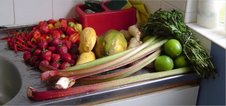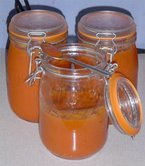
Recipes and general blithering
Oxford resident and purveyor of musical mayhem - Neph gives us the who the how but almost never the why behind the things that come out of his legendary kitchen. Not legendary in as much that they are the subject of madrigals, and if there had been any dragon's involved it would no doubt have been served with a brie and marmalade.
North African Scallops w/ Simple Salad and Ginger & Citrus Sponge Pudding w/ Whipped Chilli Vodka Cream
Having sworn for some time that I'd buckle down and start writing up recipes for my so-called cookbook, I came up with the drunken idea last week to dedicate one evening a week to "request cooking". By this I mean that one of my housemates or guests gets to nominate what they'd like to eat that week - or name an ingredient or a theme or somesuch - and I'll write up the results; I'll also be doing the nominating some of the time ... My intention is to rely less on my favourite cookbooks and branch out into, well, just making things up as I go. And maybe stealing a few ideas from the internet, natch.
I was planning to kick off with some sort of fish curry and I couldn't resist looking for inspiration in Nigel Slater's Appetite. (This wonderful book is probably the best "starter" cookbook for an enthusiastic amateur: the recipes are unpretentious and largely straightforward to follow; plus pretty much every one I've tried has been delicious.) Anyway, I started thumbing through the fish chapter and the first recipe was a very simple scallop dish. So the fish curry idea went out the window almost immediately - and my subconscious started thinking about sherry!
The recipe below is basically "according to Slater", though I've added some soft North African spicing instead of fresh parsley. (The spices came from Oxfam's harissa spice mill: a blend of dried chilli, sea salt, caraway, cumin, coriander, garlic and mint.) The scallops should be served with good brown bread to mop up the buttery juices. Tio Pepe [fino] from Gonzalez Byass was a good partner to this course; I think a manzanilla would be a little too tangy - though eminently drinkable whilst cooking, of course ;~D
Even with the bread (and salad), this dish isn't particularly filling - and since it's also very easy to prepare, I figured I could spend some time making a dessert as well. (I don't cook enough sweet things.) Again, the recipe is from Slater with some minor modifications: in this case, the addition of ground ginger and saffron. I wanted to drink Noe from Gonzalez Byass with this but was out of luck; I went for the Lustau Rich Old Oloroso instead, which is a marvellous sherry, though a sweeter wine would perhaps have worked better.
Both recipes served five.
North African Scallops w/ Simple Salad
- 25 small scallops (corals removed)
- 3 or 4 tsp freshly-ground harissa spices
- approx. 75g unsalted French butter
- 2 medium-sized cloves of strong garlic (crushed or grated)
- 150g salad leaves (e.g. rocket, watercress and spinach)
- 4 tbsp extra virgin olive oil
- 1 tsp ume seasoning
- 1 tbsp sherry vinegar
- 1 tbsp fresh lemon juice
Coat the scallops with the spices. Melt half of the butter in a large skillet on a high heat. Once it starts to colour, throw in the scallops and cook for two or three minutes. Turn and cook for another minute or two, then remove to warmed plates. Throw out the brown butter and add the other half of the butter to the pan (still on a high heat). As it froths, add the crushed garlic and swirl it around for about thirty seconds. Pour over the scallops and serve.
For the salad, shake the ume, olive oil, sherry vinegar and lemon juice together and use to dress the leaves. Simple!
Ginger & Citrus Sponge Pudding w/ Whipped Chilli Vodka Cream
- 100g unsalted French butter (at room temperature)
- 175g organic unrefined demerara cane sugar
- 2tsp ground ginger
- zest and juice of 1 large orange
- zest and juice of 1 lemon
- 3 large duck eggs
- 40g plain flour
- 400 ml milk
- 10-12 strands of saffron
- 550 ml Jersey double cream
- approx. 100ml chilli vodka
Soak the saffron strands in the milk. Cream together the butter, sugar and ground ginger until light and fluffy. If you can't be bothered to put this much effort in, use a food processor - or accept that the pudding won't rise as much as it might otherwise (though it will still taste great). Zest the orange and lemon and set aside, along with the juice from both.
Separate the duck eggs: set aside the whites and add the yolks to the creamed mixture. Don't worry if it curdles! Add the flour and milk alternately until the mixture has the consistency of a batter. (This is also more easily done in a food processor.) Stir in the citrus zest and juice.
Beat the eggs whites until stiff - definitely in a food processor! - then fold these carefully into the batter. Pour into a large oven-proof bowl and stand in a roasting tray half-filled with hot water. Bake at 180^C for about an hour until golden and spongy, then allow to cool for five minutes before serving with the whipped cream.
The chilli vodka should be made in advance. For this batch, five small Thai red chillies were sliced open and put in a half-full bottle of Reyka vodka. After four or five days, the vodka was strained - and nicely spicy! Some of this vodka was then whipped with the cream until thick and gloopy.
Neph’s Fruity Chilli Sauce (Strawberry Version)
From this...

to this...

There’s no shame in admitting it: I’m addicted to chilli! And my circle of friends is becoming addicted to my chilli sauces … What follows is the third iteration of my ever-changing - and slightly seasonal - recipe and is runnier than the previous two. Also, thanks to the strawberries, it’s more suited to “sweet” rather than “savoury” uses – though you might be surprised at its versatility. I haven’t yet tried it with cheese but I can vouch that it makes a heavenly partner for good vanilla (or chocolate) ice cream. It’s also handy for adding a kick to everything from stir-fries to salad dressings – and it goes remarkably well with a simple omelette.
Most of the fruit came from Tahmid stores on the Cowley Road, except for the strawberries and rhubarb, which came from Melton Manor Farm – it’s just a quick bike ride across the edge of Port Meadow for me! You can get kuzu and the apple balsamic vinegar from Uhuru Healthfoods on the Cowley Road; vitamin C powder can be obtained from Holland & Barrett (though they hide it under the counter for some reason).
The sauce usually keeps pretty well but you might want to store it in the fridge. And don’t forget to wear gloves when chopping the chillies!
~ 1 large bunch of mint (washed)
~ 7 large limes
~ 3 small mangoes
~ 1 large papaya
~ 40 Scotch Bonnet chillies
~ 40 small red Thai chillies
~ 600g root ginger
~ 700g English rhubarb
~ 600g English strawberries
~ 200ml Reyka vodka
~ 6 tsp vitamin C powder
~ 150ml Thorncroft elderflower cordial
~ 2 tsp Maldon sea salt
~ 4 tsp kuzu
~ 250ml apple balsamic vinegar
Roughly shred the mint leaves and steep overnight in the vodka. Strain the liquid – and discard the leaves – before using.
Trim and roughly chop the chillies, keeping the seeds. Place in a large saucepan (or stockpot) and add the balsamic vinegar and an equal volume of water. Bring to a gentle simmer, turn down the heat as low as possible and cover. Zest the limes and add this to the pan, along with their juice. Peel and grate the ginger, chop the rhubarb and bung all this in.
After about 15 minutes, add the elderflower cordial and salt and continue cooking uncovered. Peel and dice the papaya and mango and add to the pan, along with the quartered strawberries. Turn up the heat and let the sauce bubble gloopily, stirring all the while. Mix the finely ground kuzu with some liquid from the pan and stir this in; also add the vitamin C at this stage. Remove from the heat, cover and leave to cool. Once cool, blend in batches and then refrigerate overnight.
The next day, heat thoroughly, then remove from the heat and add the mint-flavoured vodka. Stir well and bottle whilst hot.
Tagliatelle with Artichoke Hearts, Wet Garlic and Lemon Thyme
We've come to the conclusion that we eat too much meat, so a conscious decision has been taken to cook more vegetarian dishes; in fact, I'm threatening to have an all-vegetarian August … In any case, these lighter meals suit the muggy evenings we've been having lately. The following pasta dish is a doddle to prepare and thoroughly delicious. (The quantities given should satisfy three people.)
The wet garlic came from Melton Manor Farm (off Binsey Lane) in Oxford. (Their wonderful smoked garlic should also be on sale within the next few days.) The truffle-flavoured olive oil is from Waitrose – well worth the 9-mile trek down the Thames Path last weekend!
A variation on this meal would substitute broad beans for the artichoke hearts and dried pasta for the tagliatelle; I'd also add a couple of chopped red Thai chillies to this version.
~ 400g fresh egg tagliatelle
~ 5 gloves wet garlic (roughly chopped)
~ 8 or 10 small stalks of lemon thyme
~ 9 asparagus hearts (chopped into chunks)
~ 100 ml double cream
~ 1 tbsp truffle-flavoured olive oil
~ 25g unsalted butter
Place the chopped artichoke hearts on a plate in an oven at 100oC.
Bring a pan of salted water to the boil, add the tagliatelle, return to the boil, stir once and simmer vigorously for 3 or 4 minutes. Drain and toss with the olive oil.
Meanwhile, melt the butter over a medium heat and add the garlic. After a couple of minutes, add the lemon thyme leaves and artichoke hearts (warm from the oven). Whilst the pasta is draining, add the cream and some black pepper, heat through , pour over the pasta and serve with a green salad.
Pigeon Breast Stew with Chorizo, Lentils and Black-eye Beans
The lamb stock used in this inaugural dish had an extended gestation, the delineation of which would require a meandering yarn worthy of Abe Simpson … Back in the middle of April I remember it was when I found myself buying some lamb shanks, which were the only source of diceable lamb in those days. As the meat casseroled, I made a thin broth from the bones. A week or so later, to accompany a roast shoulder of lamb with anchovies – or Spanish sea wieners as we used to call them – I used the broth to steam some carrots (as was the fashion at the time, natch). The broth was then simmered down with the shoulder bone, producing – after some initial skimming, and later cooling followed by further fat removal – a richly colloidal and thoroughly comforting lamb stock
As if the chorizo in this recipe didn’t provide enough in the way of porcine fats, I also adulterated the stock with some gravy salvaged from the bangers and mash that G had cooked the previous night. I can’t swear to the exact constituents, though sausage oozings, onions, Noilly Prat, dried sage and a little of my plum chutney were all involved for sure. I meant to add a few crushed juniper berries as well; with hindsight, I’m glad I didn’t. Gamey, yes, but pigeon is closer in character to hare and pheasant than venison and correspondingly less suited to the sour astringency of juniper.
The pigeon breasts came from Feller’s in the Covered Market in Oxford: about six quid for ten breasts, which will feed five people.
~ 1 litre of lamb stock
~ 200g brown lentils (rinsed in cold water)
~ 250g black-eye beans (soaked for 8 hours, then rinsed in cold water)
~ 200g chorizo (sliced into fairly thin chunks)
~ 3 tbsp rye flour
~ 1 tsp hot paprika
~ 1 tsp dried chillies (moderate heat, e.g. guajillo)
~ 10 wood pigeon breasts
~ 150ml red wine
~ 2 small red onions (sliced into rings)
~ 2 small brown onions (sliced into rings)
~ 15g dark chocolate
Gently heat the lamb stock and add the lentils and black-eye beans, along with any blood from the pigeon breasts. Add the chorizo and bring to a gentle simmer.
Season the flour and mix in the paprika and dried chillies; use to coat the pigeon breasts. Bring a little olive oil to a high heat and brown the breasts (in batches, if necessary) – two or three minutes on each side should be fine. Remove the breasts to the stew then deglaze the pan with the red wine. Add the red and brown onions and cook for about five minutes. (Keep the heat up and let half the wine bubble excitedly away.) Transfer the onions and juices to the stew and cook for another hour or so, stirring occasionally; cover the pan and turn down the heat to the barest simmer for most of this time.
About fifteen minutes or so before serving add the chocolate and stir thoroughly. Serve with bread.

